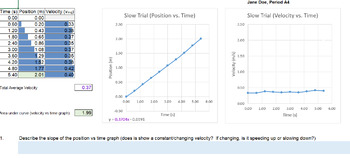Water Droplet Velocity and Displacement Activity
Kimberly Gahn
4 Followers
Grade Levels
8th - 12th, Homeschool
Subjects
Resource Type
Standards
CCSSMP4
NGSSHS-PS2-1
Formats Included
- Zip
- Excel Spreadsheets
Kimberly Gahn
4 Followers
Description
This is a fairly simple to perform data collection activity to illustrate the concepts of one-dimensional motion and the associated graphing techniques. Students will use plastic water bottles to perform a series of motions and collect data. The data can then be analyzed using included Excel automatically calculating workbooks in two follow-up lessons. This activity can easily be performed in a distance learning setting as it uses materials found in most households.
Total Pages
Answer Key
N/A
Teaching Duration
2 days
Report this resource to TPT
Reported resources will be reviewed by our team. Report this resource to let us know if this resource violates TPT’s content guidelines.
Standards
to see state-specific standards (only available in the US).
CCSSMP4
Model with mathematics. Mathematically proficient students can apply the mathematics they know to solve problems arising in everyday life, society, and the workplace. In early grades, this might be as simple as writing an addition equation to describe a situation. In middle grades, a student might apply proportional reasoning to plan a school event or analyze a problem in the community. By high school, a student might use geometry to solve a design problem or use a function to describe how one quantity of interest depends on another. Mathematically proficient students who can apply what they know are comfortable making assumptions and approximations to simplify a complicated situation, realizing that these may need revision later. They are able to identify important quantities in a practical situation and map their relationships using such tools as diagrams, two-way tables, graphs, flowcharts and formulas. They can analyze those relationships mathematically to draw conclusions. They routinely interpret their mathematical results in the context of the situation and reflect on whether the results make sense, possibly improving the model if it has not served its purpose.
NGSSHS-PS2-1
Analyze data to support the claim that Newton’s second law of motion describes the mathematical relationship among the net force on a macroscopic object, its mass, and its acceleration. Assessment is limited to one-dimensional motion and to macroscopic objects moving at non-relativistic speeds. Examples of data could include tables or graphs of position or velocity as a function of time for objects subject to a net unbalanced force, such as a falling object, an object sliding down a ramp, or a moving object being pulled by a constant force.


